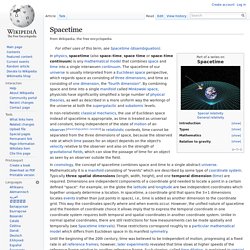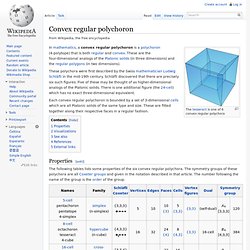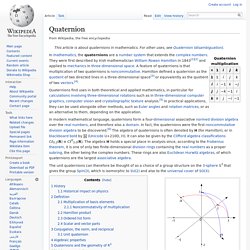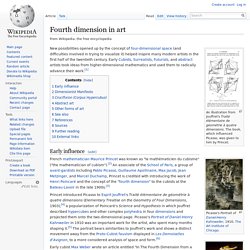

Spacetime. In non-relativistic classical mechanics, the use of Euclidean space instead of spacetime is appropriate, as time is treated as universal and constant, being independent of the state of motion of an observer.

[disambiguation needed] In relativistic contexts, time cannot be separated from the three dimensions of space, because the observed rate at which time passes for an object depends on the object's velocity relative to the observer and also on the strength of gravitational fields, which can slow the passage of time for an object as seen by an observer outside the field. Until the beginning of the 20th century, time was believed to be independent of motion, progressing at a fixed rate in all reference frames; however, later experiments revealed that time slows at higher speeds of the reference frame relative to another reference frame.
Such slowing, called time dilation, is explained in special relativity theory. Four-dimensional space. In modern physics, space and time are unified in a four-dimensional Minkowski continuum called spacetime, whose metric treats the time dimension differently from the three spatial dimensions (see below for the definition of the Minkowski metric/pairing).

Spacetime is not a Euclidean space. History[edit] An arithmetic of four dimensions called quaternions was defined by William Rowan Hamilton in 1843. This associative algebra was the source of the science of vector analysis in three dimensions as recounted in A History of Vector Analysis. Soon after tessarines and coquaternions were introduced as other four-dimensional algebras over R. One of the first major expositors of the fourth dimension was Charles Howard Hinton, starting in 1880 with his essay What is the Fourth Dimension? Little, if anything, is gained by representing the fourth Euclidean dimension as time. Vectors[edit] This can be written in terms of the four standard basis vectors (e1, e2, e3, e4), given by.
Convex regular polychoron. The tesseract is one of 6 convex regular polychora In mathematics, a convex regular polychoron is a polychoron (4-polytope) that is both regular and convex.

These are the four-dimensional analogs of the Platonic solids (in three dimensions) and the regular polygons (in two dimensions). These polychora were first described by the Swiss mathematician Ludwig Schläfli in the mid-19th century. Schläfli discovered that there are precisely six such figures. Quaternion.
Graphical representation of quaternion units product as 90°-rotation in 4D-space, ij = k, ji = −k, ij = −ji History[edit] Quaternion plaque on Brougham (Broom) Bridge, Dublin, which says: Here as he walked by on the 16th of October 1843 Sir William Rowan Hamilton in a flash of genius discovered the fundamental formula for quaternion multiplicationi2 = j2 = k2 = ijk = −1 & cut it on a stone of this bridge Quaternion algebra was introduced by Hamilton in 1843.[7] Important precursors to this work included Euler's four-square identity (1748) and Olinde Rodrigues' parameterization of general rotations by four parameters (1840), but neither of these writers treated the four-parameter rotations as an algebra.[8][9] Carl Friedrich Gauss had also discovered quaternions in 1819, but this work was not published until 1900.[10][11] i2 = j2 = k2 = ijk = −1, into the stone of Brougham Bridge as he paused on it.

On the following day, Hamilton wrote a letter to his friend and fellow mathematician, John T. 4-manifold. In mathematics, 4-manifold is a 4-dimensional topological manifold.

A smooth 4-manifold is a 4-manifold with a smooth structure. In dimension four, in marked contrast with lower dimensions, topological and smooth manifolds are quite different. There exist some topological 4-manifolds which admit no smooth structure and even if there exists a smooth structure it need not be unique (i.e. there are smooth 4-manifolds which are homeomorphic but not diffeomorphic). Fourth dimension in art. An illustration from Jouffret's Traité élémentaire de géométrie à quatre dimensions.

The book, which influenced Picasso, was given to him by Princet. New possibilities opened up by the concept of four-dimensional space (and difficulties involved in trying to visualize it) helped inspire many modern artists in the first half of the twentieth century. Early Cubists, Surrealists, Futurists, and abstract artists took ideas from higher-dimensional mathematics and used them to radically advance their work.[1] Early influence[edit] Dalí's 1954 painting Crucifixion (Corpus Hypercubus) Princet introduced Picasso to Esprit Jouffret's Traité élémentaire de géométrie à quatre dimensions (Elementary Treatise on the Geometry of Four Dimensions, 1903),[4] a popularization of Poincaré's Science and Hypothesis in which Jouffret described hypercubes and other complex polyhedra in four dimensions and projected them onto the two-dimensional page.
Dimensionist Manifesto[edit] 1.